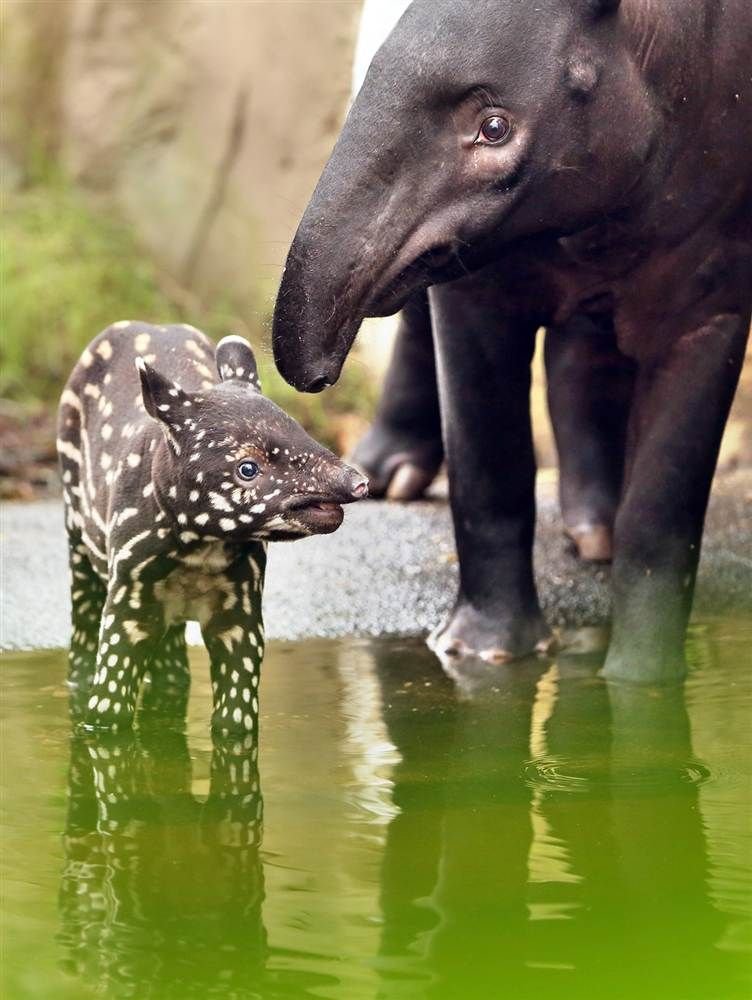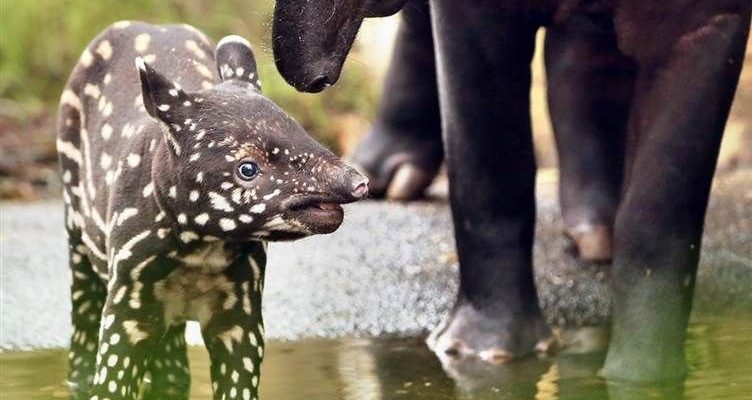
Tapirs are often referred to as living fossils because they closely resemble ancient creatures. They come in several species, including the Baird’s tapir, the Malayan tapir, and the Brazilian tapir, each with its own set of behaviors and habitats. Understanding how tapirs raise their young gives us a glimpse into their world and highlights the importance of preserving their environments. So, let’s dive into the intriguing lives of these remarkable animals!
Understanding Tapir Gestation and Birth
The journey of a tapir family begins with a pregnancy that lasts about 13 months. That’s almost a year and a half! During this time, the mother tapir will often seek a safe place to give birth, typically in dense vegetation to protect her newborn from predators. This habitat resembles a cozy nursery, providing a sense of security for both mother and baby.
When it’s time to give birth, the mother tapir can be quite secretive. She will usually separate herself from the group and find a secluded spot to welcome her calf into the world. Just like humans, tapir mothers form a strong bond with their young right from the moment they are born. A newborn tapir, called a calf, is usually born with a spotted coat that helps it blend into the forest floor, much like a fawn. This camouflage is nature’s way of keeping the little one safe from prying eyes.
After birth, the calf is surprisingly mobile. Within a few hours, it can stand and walk, which is crucial for escaping predators. The mother remains close, guiding her calf as it takes its first wobbly steps into the wild. You might be wondering how she ensures her baby stays safe—let’s look into that next.
Mother Tapirs and Their Parenting Style
Mother tapirs are dedicated caregivers, much like how human parents prioritize their children’s well-being. They are attentive and protective, often staying close to their young for a while. The calf will nurse for about six to eight months, which is a critical time for its growth. In addition to milk, the mother begins introducing solid food, such as leaves and fruits, to help develop the little one’s digestive system.
Interestingly, while tapirs are generally solitary animals, the mother will instill a sense of independence in her calf. She encourages exploration, allowing the young tapir to wander a bit while keeping a watchful eye. This balance between protection and freedom helps the calf learn essential survival skills, such as foraging for food and recognizing potential threats.
It’s quite a sight to see a mother tapir guiding her little one through the dense underbrush, showing it where to find the juiciest plants. You might even picture them playing together, a heartwarming image that emphasizes the strong bond they share. But what happens if danger arises? Let’s explore how tapirs navigate threats in the wild.
Staying Safe: How Tapirs Protect Their Young
In the wild, safety is a top priority for tapirs. Mother tapirs are quite aware of their surroundings and will often position themselves between their calf and any potential danger. They have an acute sense of smell and hearing, helping them detect threats from a distance. This vigilance is crucial, as predators like jaguars or large snakes are always lurking nearby.
If a threat does appear, the mother tapir may use distraction tactics to keep her calf safe. For instance, she might make loud noises to deter predators or lead them away from her young one. This protective instinct is similar to how many animals, including humans, instinctively prioritize their offspring’s safety above their own.
Another fascinating aspect of their survival strategy is the calf’s natural instinct to hide. When danger looms, a young tapir will often freeze in place, relying on its camouflage to blend in with the environment. It’s nature’s clever way of ensuring survival—similar to how some prey animals hide to avoid being seen.
Weaning and Independence: Growing Up Tapir
As the months go by, the bond between mother and calf starts to shift. The weaning process typically begins around six months, where the mother gradually reduces nursing. This transition helps the young tapir become more independent and begins its journey into adulthood.
The diet of a baby tapir expands significantly during this time. They start to eat more leaves, fruits, and even aquatic plants, mimicking their mother. Watching them try new foods can be quite entertaining! Imagine a little tapir curiously munching on a strange-looking leaf for the first time—it’s a delightful reminder of childhood exploration.
After about a year, the calf will start venturing out on its own, but it may stay close to its mother for a while longer. This gradual separation is crucial for their development, allowing them to learn how to find food and avoid predators. It’s a bittersweet process, as mothers must let their babies go, but it’s all part of the natural cycle.
The Importance of Tapir Conservation
Sadly, tapirs face various threats, including habitat loss and poaching. As these gentle creatures work hard to raise their young in the wild, their environments are rapidly changing. It’s essential for us to recognize the significance of tapir conservation efforts. Protecting their natural habitats ensures they have the space and resources they need to thrive and raise future generations.
Organizations around the world are dedicated to tapir conservation, focusing on habitat preservation, education, and research. Supporting these initiatives can make a significant difference. Whether it’s through spreading awareness or contributing to conservation projects, every little bit helps.
You might be wondering how you can get involved. Simple actions like advocating for wildlife protection or even learning more about tapirs and their ecosystems can contribute to their survival. By caring for tapirs, we honor not just a unique species, but also the entire ecosystem they support.
Raising young in the wild is a profound journey for tapirs, filled with challenges and incredible moments. From the protective instincts of the mother to the playful curiosity of the calf, their parenting style is a testament to the beauty of nature. By understanding how tapirs raise their young, we gain a deeper appreciation for these fascinating animals and the need to protect their habitats.
As you sip your coffee and reflect on the amazing world of tapirs, remember that every effort to conserve their space can have a lasting impact. With each generation raised in the wild, tapirs not only contribute to their species’ survival but also help maintain the delicate balance of their ecosystems. So, let’s celebrate these remarkable creatures and support their journey into the future together!

